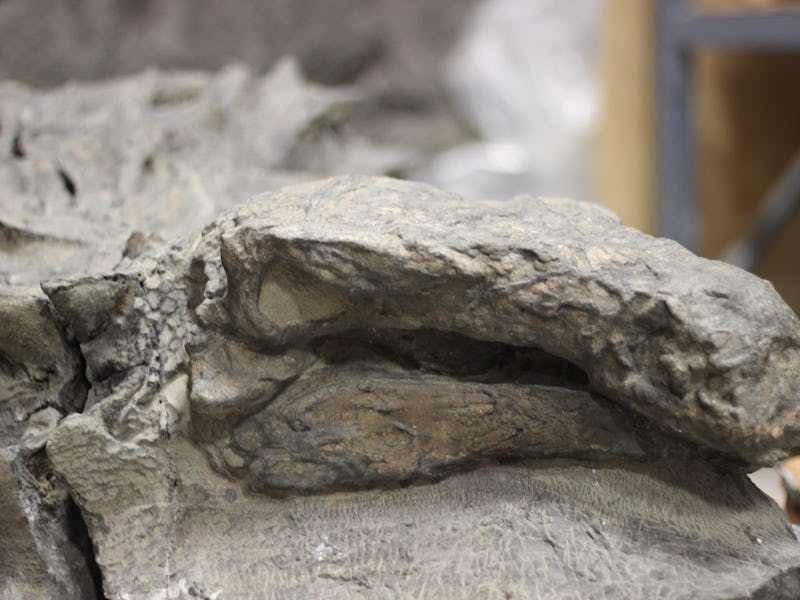This Perfectly Preserved Dinosaur Is One in a Billion
He was digging for oil. What he struck instead is far more interesting.

Six years ago, a heavy machine operator was stripping away soft sandstone rock at a Canadian oilsands mine when his bucket hit something very large and very hard. In the rock that fell away from the cliff, he noticed strange patterns that didn’t look much like the fossilized wood he sometimes comes across. It was enough to make him stop and take a closer look — a decision that set off a massive operation to recover the most well preserved armored dinosaur ever found.
The dinosaur Shawn Funk stumbled upon that day turned out to be an 18-foot-long nodosaur — a large herbivore in the ankylosaur family known for its large spiky body armor. It had been preserved nearly perfectly for 110 million years, in three dimensions, inside a concrete-like tomb. The specimen went on display at the Royal Tyrrell Museum in Drumheller, Alberta, last week, after 7,000 hours of preparation.
“It’s one in a billion,” Don Henderson, curator of dinosaurs for the museum, told Inverse during a visit last August, when the nodosaur was still mid-preparation. That’s literally true — more than a billion cubic meters of rock had been moved at the Suncor mine to that point, all of it completely dinosaur-free. And then there was this.
Don Henderson sits in his office at the Royal Tyrrell Museum in Drumheller, Alberta.
How this particular animal ended up at that particular spot and became entombed in such a way that it did not rot away, erode, dissolve, or collapse is a geological and chemical marvel.
That spot 110 million years ago would have been seabed — the bottom of the Western Interior Seaway that once split North America from north to south. Henderson supposes that the landlubber nodosaur died in a flood and was swept with the water to a river and ultimately out into the ocean.
The nodosaur went on display at the Royal Tyrrell Museum in May.
“Because its armored hide was so thick and so strong it could contain very high gas pressure and allow him to float belly up well out into the seaway,” says Henderson. “But eventually he did go pop and he sank to the bottom like a stone.”
He really hit the bottom hard — the impact crater was visible in the mine’s cliff wall where the animal was found. It stirred up enough dirt to cover the animal quickly in the muck, and then some chemical magic started happening.
“As the carcass decays, it’s going to release various chemical compounds, and it changes the water chemistry around it,” Henderson says. “And if you can make the water chemistry more alkaline, then you’ll get precipitation of carbonate minerals, which bind the sand together in a really strong way.”
A model nodosaur sits atop an actual nodosaur. Future models will be more accurate thanks to this discovery.
The resulting mineralization is called a concretion, and it is well named. Industrial cement is also made of carbonates, and works in the same way to bind loose rocks and sand into concrete.
In this way, the nodosaur built itself a tomb of solid rock, more than a foot thick in all directions. While most fossils in Alberta have been squished flat under the pressure of a half mile of Earth that once lay above them, this animal was protected by this massive concretion.
The black material is a thin, fingernail-like skin that covered the nodosaur's bony armour. The tan material is bone, and the brown stripes are tendons.
When dinosaur bones survive long enough for us to find them, it is often due to a process called permineralization. Over time and under pressure, mineral-rich waters flow through the bone and, in the right conditions, begin to crystallize inside the bone’s pores, strengthening it and ultimately turning it to stone. This process creates what we normally think of when we think of fossils — rocks in the shape of the animal that once was.
But this nodosaur is no ordinary fossil. Inside the concrete tomb, bones had essentially turned to dust.
The bones have the consistency of pressed talcum powder, says Henderson. This left preparator Mark Mitchell with an extraordinary task — get rid of the concrete tomb but save all the soft material inside it. “You’ve got this absolutely evil hard concretion, and right next to it, it’s super soft bone. It took great skill to do what he did,” says Henderson. “Every square millimeter of that thing that you see, Mark’s had to consolidate it with a drop of glue, or many drops. It’s not your average dinosaur fossil.”
Storage boxes hold fossilized remains of the nodosaur's stomach.
The whole animal — save a tail and hind limbs, taken away from the mine pit by dump truck before anyone was the wiser — is still there, though chemically transformed. Even the contents of its stomach are intact. They take the form of a soccer-ball sized lump of rock that appears to be full of pebbles, although Henderson suspects these are the fossilized remains of partially digested fruits and seeds — our friend’s last meal.
Nodosaur animals are rare to begin with — the armored dinosaurs are believed to have been solitary and territorial beasts, sparsely populated on the landscape. “To get a land animal preserved out at sea, that’s even more rare,” says Henderson. If there are others like him still out there, they are covered in dense forest, unlikely to be exposed by natural means. So it’s only by terribly lucky chance, in the rare spots where we peel back the Earth, that a creature like this might see the light of day again.